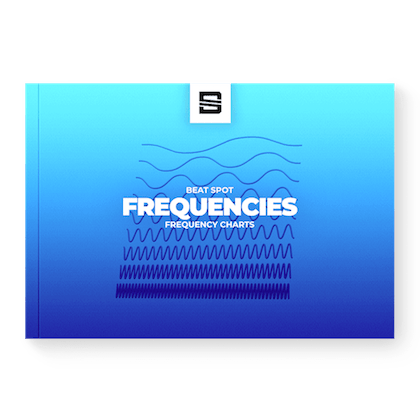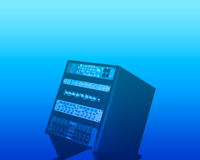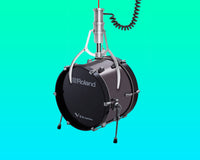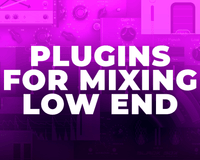A clicking synth can be a frustrating problem for musicians and producers, as it can detract from the overall quality of the sound.
Besides dirtying up the sound, clicks and pops can become annoying, especially if they’re going through processing such as saturation and compression, and come out significantly loud, making them even harder to deal with.
So the rule of thumb is to take them off or tame them as much as possible right from the synth or as the first step during post-processing.
- First off, check if your system isn’t the problem. Going in order is crucial, so you can exclude factors reliably.
- Turn up the buffer size. This will cause some playback latency, but it will make sure the CPU isn’t much stressed. Make sure to keep an eye on it and see if it’s overloaded. However, CPU-related problems should manifest during audio playback in general and not when it’s starting or stopping.
- Before proceeding with the rest of the checklist, I’d try exporting the track and playing it back on different systems. If the clicks aren’t there, then the problem is in your playback system and not something actually happening within the project.
- Make sure the problem is not related to your specific synth version. In that case, try updating or downgrading it to a version that doesn’t have this problem.
- Try the synth patch on a blank project. If it’s not clicking anymore, your current project might be too much to handle, especially if you have several processors on groups and buses.
- Try other synths with the same settings and see if they’re clicking, too. If yes, then you’re designing the patch suboptimally.
- Then move on to samples, especially sub basses, and 808s. Play with smooth clip fades and see if the problem persists.
- If the problem persists, there might be a reason to fear that hardware is failing somewhere. The problem can be your audio interface, the cables, your speakers, or headphones. I once experienced a similar problem with my headphones not reproducing sub bass evenly across the two pavilions, with one side sounding a bit more saturated than the other.
If you’re sure nothing listed until now is something you should worry about, then a clicking synth can be caused by several factors.
To troubleshoot a clicking synth, it is important to isolate the offending factors and eliminate them one by one. Start by disabling each module and parameter individually until the click stops or is reduced to an acceptable level. Then, turn everything back on and pay attention to any clicks that reappear. This process of elimination will help you to identify and eliminate the factors that are causing the clicks, allowing you to achieve a clean, smooth sound.
Fixing clicks within the synth
Here are some common causes for a synth to click:

Low End
One common reason for a clicking synth is excessive low-end going through heavy processing. When processing is applied to the low end of a sound, it can cause clicks and other unwanted artifacts. This is mostly due to the wavelength of low frequencies, which must be fed into timely and accurate dynamic processing.

Envelopes
Envelopes with too fast an attack/release can also cause a clicking synth. Envelopes are used to shape the sound over time, controlling the amplitude, filter cutoff, and other parameters. The duration of each ADSR step is not the only thing to consider. Also, the curve shape plays a role. Try smoothing out the problematic step.

Abrupt LFOs
Following the same logic, another factor that can cause a clicking synth is LFOs with sharp or abrupt curves. LFOs (low-frequency oscillators) are used to modulate parameters such as filter cutoff, amplitude, and panning.
If you want to use this kind of LFO shape, try the Smooth feature (or anything similar, if available); otherwise, turn the abrupt curve into a short and smoother one. Sometimes it’s just a matter of a few milliseconds to let the sound be modulated from one point to another fast enough that you don’t notice the difference but slow enough not to disrupt wave cycles.

Voices
Using too many voices can also contribute to a clicking synth. A voice refers to an individual instance of a sound that is being played at the same time. When too many voices are being played simultaneously, it can cause the processing algorithms to struggle and lead to clicks and other unwanted artifacts.
Let’s say our synth is set to reproduce no more than 16 voices at the same time. If the synth patch has 9 voices, they’ll add up to 18 as soon as two notes overlap. This requires the synth to shut down 2 voices from the previous triggered note immediately in order to stay within the 16 voices limit.
The solution can be turning up the maximum voice count or turning down the unison.
Generally, the latter is the better choice since most sounds don’t actually need many voices to sound as detuned as you want them to.

Dynamic Processing
Heavy full-band or OTT compression can also cause a clicking synth. Compression is used to control the dynamic range of a sound, making it more consistent in volume. When compression is applied too heavily, it can make this problem manifest for the same wavelength reason as stated previously.
OTT, in particular, can be problematic since it can spread the click across multiple bands, making it harder to deal with while maintaining OTT as part of the chain.
The same thing stands for when using gates.

Phase Position
A problem with the phase not restarting at a Zero-Crossing point, especially on sine wave-based or similar wavetables, can also cause a clicking synth. The phase of a wave refers to its position in its cycle, and the zero-crossing point is the point at which the wave passes through zero amplitude. When the phase is not restarted at the zero-crossing point, it’s reproduced as a very short square wave, causing the synth to click.

Cutoff Frequency
Finally, a problematic cutoff frequency of filter types with steep notches can also contribute to a clicking synth. Filters are used to control the frequency content of a sound, and the cutoff frequency is the point at which the filter begins to reduce the level of the sound. When the cutoff frequency is set to a value that doesn’t work well with your specific frequency content (made up of the number of harmonics, their specific relative distribution, and also the note being played), it’s possible to experience clicks.
If your MIDI pattern doesn’t move much from the problematic note, you can fine-tune the filter and leave it static; otherwise, you can use the key tracking function, if available, to make the filter move accordingly with the triggered note and see if that solves your problem.
Fixing clicks outside the synth
If nothing worked, it’s time to move to the post-processing stage.
Lowpass
In the case of sounds with little or no harmonic content, you can opt for a lowpass filter. This is a viable solution when using sidechain compression on sub-bass, too, as the quick and drastic change in volume can disrupt wave cycles far from Zero-Crossing points. Just make sure you aren’t killing the harmonics of the sound, changing it in a way that doesn’t reflect the intended big picture.
Gating
If the click happens at a very low volume and the sound allows it to, consider using a Gate if it doesn’t kill the envelope or change it in an undesired way.
If the patch has reverb or delay going on, consider turning them off, placing the gate, and then following with the disabled effects afterward.
This way, you won’t kill the decay of the reverb or truncate the reflections of the delay while still dealing with the click.
This procedure also ensures the click isn’t being reverberated or reproduced by the delay.
Consolidate
Lastly, you can print the patch to audio and fix the problem with volume automation and clip fades. This is the most time-consuming solution, and it also requires you to have the patch designed with no need for eventual changes. That being said, it’s been listed at the bottom of the article because it’s the last resort that comes to my mind.
Conclusion
If your synth is clicking, it’s mostly due to you overloading software and hardware excessively for no tangible improvement or things happening too fast and disrupting wave cycles (especially the longest ones).








